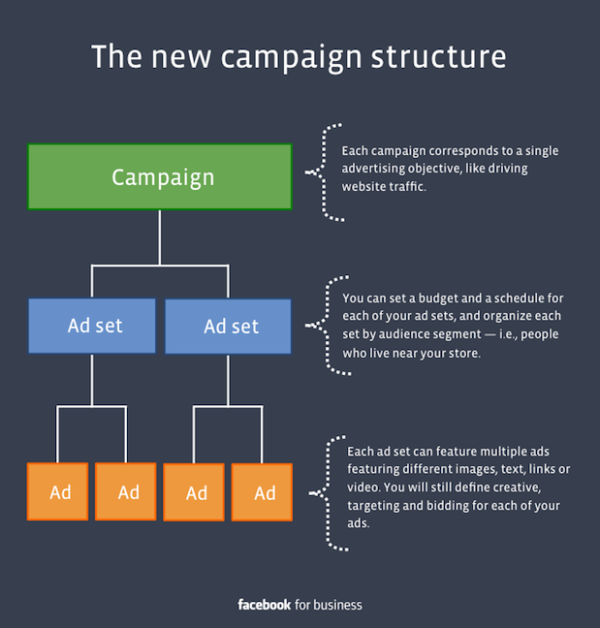A Well Needed Change Will Simplify (& Revolutionize) Facebook Ad Campaigns
Until today, Facebook campaigns consisted of two things: campaigns and ads. On March 4th, this will change to include another level, the ad set. This additional level of structure will have Facebook advertisers rejoicing as there will be a clear format for organization, tracking and administration within the core Facebook ad product. The problem with […]
Until today, Facebook campaigns consisted of two things: campaigns and ads. On March 4th, this will change to include another level, the ad set. This additional level of structure will have Facebook advertisers rejoicing as there will be a clear format for organization, tracking and administration within the core Facebook ad product.
The problem with the old Facebook Campaigns was that there was nearly no way to properly run a marketing campaign without outside tools. Two main problems existed that hindered the marketing efforts with Facebook ads. Firstly, the sheer number of campaigns that were required to separate initiatives was outstanding. The campaign was previously the only form of segregation and advertisers would need to spin up a new Campaign for any type of specific budget.

The other issue that advertisers faced was that they would load a campaign up with ads galore and would struggle to ensure that the right budget went to the right ads. Advertisers would load thousands of specifically targeted ads into a Campaign with no easy way to sort or filter. Of course, when too many ads were dumped into a Campaign, the reporting and tracking would become unmanageable.
The fundamental change that will be released to advertisers on March 4th is the addition of the ad set. This will operate much like an ad group in Google or Bing and will allow advertisers to group ads and audiences together without having to set up a new campaign. With this change, the targeting will still occur on the ad level but can be grouped together within an ad set*. Additionally, users will be able to set a budget and schedule for Facebook Ads directly with the ad set (unlike AdWords).
The reason this is such a big change is the sheer number of hours it will save marketers who aren’t using advanced tools. As an example, let’s say that a user had the initiative of advertising a spring sale to folks in cities where physical locations existed. In the current iteration of campaigns, an advertiser may set up one campaign and then create an ad for each location, attaching behavioral and geographical targeting to each ad. Want to test multiple ads? They would need to add more and more ads into the campaign, again each with their own targeting. The end result is a blend of ads in one campaign — each with a different purpose. Looking at the campaign and seeing thousands of ads with no formal organization would be daunting, to say the least.
Under the new campaign structure, an advertiser would take a very different course. They would set up an ad set for each location (instilling the targeting at the ad level*) and dumping them into an ad set that can have it’s own budget. If one location needs more budget, it will have the ability to be dialed up at the set level. An additional benefit is the sheer organization where an advertiser can hop into a campaign and see the segmented ad sets.
This change will roll out for all advertisers and all ad interfaces on March 4th and migrated automatically. For more information see the official Facebook post.
*Edited for clarification
Contributing authors are invited to create content for MarTech and are chosen for their expertise and contribution to the martech community. Our contributors work under the oversight of the editorial staff and contributions are checked for quality and relevance to our readers. MarTech is owned by Semrush. Contributor was not asked to make any direct or indirect mentions of Semrush. The opinions they express are their own.
Related stories